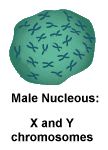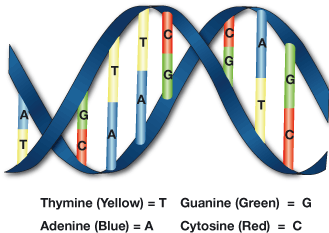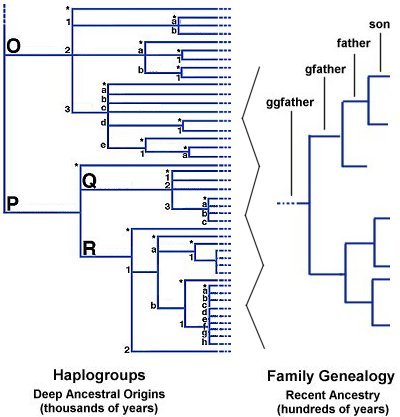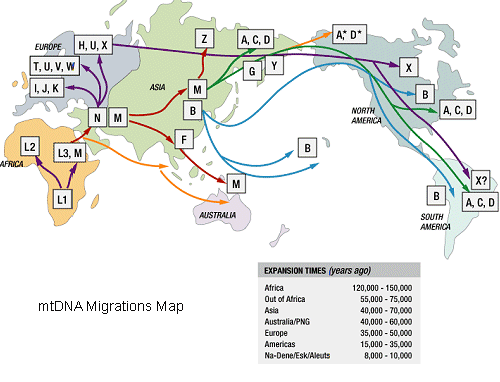

Return to DNA Test Results Index
Background Information on DNA Testing
DNA is the carrier of our genetic information, which passes from generation to generation. Every cell in our bodies, except red blood cells, contains a copy of our DNA.
At conception, a person receives DNA from both their father and mother. We each have 23 pairs of chromosomes, and for each pair, one was received from the father and one was received from the mother. These 23 pairs of chromosomes are known as nuclear DNA, since they reside in the nucleus of every cell, except red blood cells.
The 23rd chromosome is known as the sex chromosome. As with the other chromosomes, one is inherited from the father, and one from the mother. The 23rd chromosome from the mother is always an X. From the father, a person either inherits an X chromosome or a Y chromosome. The chromosome inherited from the father determines their sex. An X from the father would result in an XX which is a female, and a Y from the father would result in an XY, which is a male.
We also inherit mitochondrial DNA ( mtDNA) from our mother, and none from our father. mtDNA, which is found in abundant quantities, is located outside the nucleus of the cell.
DNA is made up of four bases: Adenine (A), Cytosine (C), Thymine (T), and Guanine (G). The order of these bases is called the DNA sequence.
Whenever a base occurs on one side, its complementary base is found on the other side. In the example see how the bases always occur in complementary pairs. In the example above, green complements red and yellow complements blue. So we can write the DNA sequence by listing the bases along either one of the two sides. For the example shown:
T G T T C G T C etc.
For Genetic Genealogy, which is the application of DNA testing to genealogy research, two areas of DNA have shown to provide information that can be used in conjunction with genealogy research. These two areas are the Y chromosome and mtDNA. These areas of the Y chromosome and mtDNA do not contain information about a persons traits or medical information. For example, the Y DNA area is known as Junk DNA by the scientists, since it does not code for personal information.
Y DNA
The Y chromosome is transmitted from father to sons. Scientists have identified a small portion, which is passed virtually unchanged. Testing of this portion of the Y chromosome provides information about the direct male line, which is the father, his father, and so forth back in time. The locations tested on the Y chromosome are called Markers. Occasionally a mutation occurs at one of the Markers in the Y chromosome. A mutation is simply a small change. These occasionally mutations, which are estimated to occur about once every 500 generations per Marker, can sometimes be valuable for genealogists in identifying a branch of the family tree.Each Marker has a name, such as DYS# 391, DYS #439 or GATA H4. The scientists classify these Markers as Short Tandem Repeat(STR) Markers. The proteins at these Marker locations are short repeats. The result for a Marker is a count of the number of repeats at the location.
The result received for a Y DNA test is a string of numbers, which represent the repeats found for each Marker. Here are some example results:
Locus
DYS#
Alleles
1
393
13
2
390
24
3
19*
14
4
391
11
5
385a
11
6
385b
14
7
426
12
8
388
12
9
439
12
10
389-1
13
11
392
13
12
389-2
29
13
458
17
14
459a
9
15
459b
10
16
455
11
17
454
11
18
447
24
19
437
15
20
448
19
21
449
30
22
464a
15
23
464b
15
24
464c
17
25
464d
17
Y-DNA Haplogroups
There are a wide variety of applications for Y DNA testing. Y DNA testing can be used to confirm the paper genealogical research for your family tree. Y DNA testing can determine which family trees with the same or variant surnames are related. Y DNA testing can provide clues to help you with your genealogy research. These are just a few of the applications for Y DNA testing.
Since the Y chromosome is only found in men, those who take the Y DNA test must be males. For females who are interested in the Y DNA result for their surname or family tree, they would request a close male relative to participate, such as a brother, father, uncle or cousin.
The results for a Y DNA Marker test also provide an estimated Haplogroup, which is predicted based on the results for the Y DNA Marker tests. The Haplogroup identifies a persons major population group, and provides information about the ancient origin of your male line. Family Tree DNA also offers a Haplogroup test, which is a scientific test of locations on the Y chromosome to confirm the estimated Haplogroup.
mtDNA
mtDNA is passed from a mother to her children. Only females pass on mtDNA. A test of your mtDNA would tell you about your mother, her mother, and so forth, up the direct female line.
Mutations occur in mtDNA, though the rate of these mutations is relatively slow. Over thousands of years these mutations build up so that one female line will have a sequence distinguishable from another. As people spread throughout the world, mutations occasionally occurred in different populations over time, allowing us to identify the origin of a person’s lineage.
mtDNA is tested and the result is compared to a reference sequence called the Cambridge Reference Sequence(CRS). By comparing an mtDNA sequence to the CRS, we can identify the name of the lineage to which you belong, which is called a Haplogroup. Many Haplogroups are continent specific and subdivisions of these Haplogroups may be regional specific.
mtDNA Haplogroups
Haplogroups are labeled alphabetically. Specific mitochondrial Haplogroups are typically found in different regions of the world, and this is due to unique population histories. In the process of spreading around the world, many populations became isolated, and specific Haplogroups, or sub Haplgroups concentrated in geographic regions. Today, Anthropologists have identified certain Haplogroups that originated in Africa, Europe, Asia, the islands of the Pacific, the Americas, and even particular ethnic groups. Of course, Haplogroups that are specific to one region are sometimes found in another, but this is due to recent or ancient migration.





